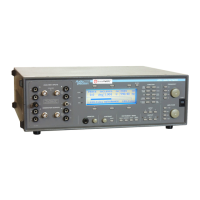In this way, a single THD+N reading can be a good indication that a
device is operating properly.
The THD+N reading alone does not tell you which type of unwanted
sound is dominant. If the reading is unexpectedly high, you may need
further testing to determine the source of the unwanted sound. More
detail on determining which type of unwanted sound is causing the
problem is given in the section Isolating Sources of THD+N on page
4-37.
To make a THD+N measurement, we begin by having the device
create or reproduce a single sinewave called the fundamental tone,
which represents the desired sound. Some of the unwanted sounds will
also be created, so the frequency spectrum may look like this:
The signal is measured with a voltmeter at this point. The measurement
will be dominated by the amplitude of the fundamental tone, since it is
at a high amplitude relative to the unwanted signals.
The signal is then run through a narrow bandreject filter to eliminate
the fundamental tone. The spectrum then looks like this:
Fundamental
Tone
Hum
Interference
Distortion
Noise
d
B
V
-140
20 20k50 100 200 500 1k 2k 5k 10k
Hz
+0
-120
-100
-80
-60
-40
-20
Figure 4-9. THD + N spectrum with fundamental
-140
+0
-120
-100
-80
-60
-40
-20
d
B
V
20 20k50 100 200 500 1k 2k 5k 10k
Hz
Fundamental
Tone Greatly
Reduced
Figure 4-10. THD + N spectrum with fundamental filtered
Understanding THD + N FUNCTION Descriptions
4 Functions
4-12 ATS-1 Access User's Manual

